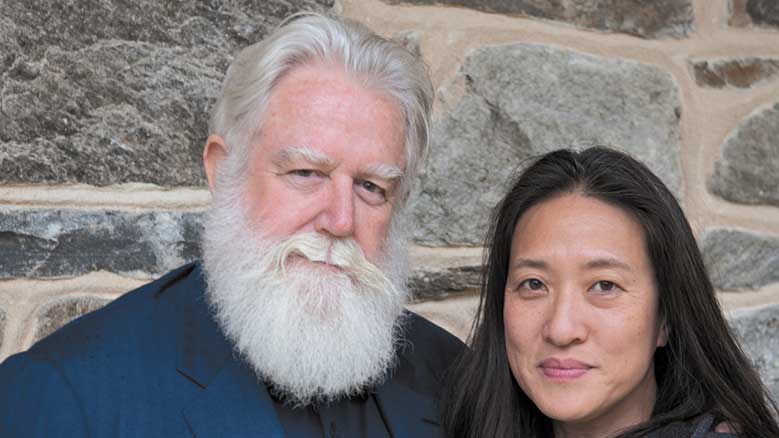
Use the media player above or right-click here to download an audio version of this article.
Contemporary light artist James Turrell visited the Philadelphia, Pennsylvania, area this past October for the opening of his new Skyspace installation at Chestnut Hill Meeting. Turrell has made an impressive career of creating spaces and works that explore the medium of light as it interacts with the human perception. Also known for his Quaker faith, he is clear to point out his work is primarily situated in the art world and not explicitly within a religious context. Still, many Friends Journal readers may have first heard Turrell’s name when learning of his involvement with a Friends meeting in Houston, Texas (“James Turrell: Spirit and Light,” FJ March 1999). Live Oak Meeting’s building was the first Quaker meetinghouse to feature Turrell’s signature Skyspace (completed in 2000), a paneless window framing the sky built into the ceiling of the meeting room. When I interviewed Turrell a week before the public opening of the Chestnut Hill Skyspace, an experiential art piece also called “Greet the Light,” my first question for him was from a viewpoint that accepts the mixing of Quakerism and art. However, putting art in a meetinghouse is often considered contradictory and inappropriate to more traditional Quakers, who still believe art and design to be vanities. “Sometimes I tend to agree with that,” admits Turrell with a smile and an obvious sense of self-awareness.
Turrell was born in Los Angeles County, California, into a Wilburite Quaker family who attended Villa Street Meeting in Pasadena—a meeting that was established in the late 1890s by western-migrating Friends from Ohio Yearly Meeting (Conservative) and later transferred to Iowa Yearly Meeting (Conservative) in 1917. The meeting was laid down in the 1980s, long after Turrell had left the area. He grew up in a household with plain speech and plain dress. He says many of his family members were and still are taken aback at his venture into art. His ancestors came through Guilford County, North Carolina, and were a part of the theological schisms that eventually split the Gurneyites and the Wilburites. Turrell, who now divides his time between his home in Oxford, Maryland; his cattle ranch in Northern Arizona; and traveling for his work, says he sometimes returns to his roots in North Carolina, often to see Max Carter, the director of the Quaker Studies Program at Guilford College and a recorded Friends minister in North Carolina Yearly Meeting (Friends United Meeting). Turrell and his wife, Kyung-Lim Lee, are now members of Third Haven Meeting in Easton, Maryland, which still uses its original meetinghouse built in 1684, reputed to be the oldest frame construction worship place in the United States.
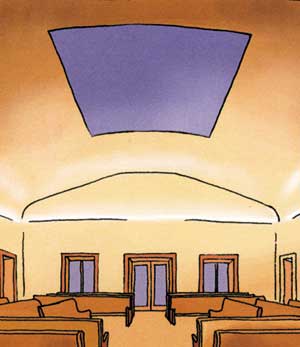
Many visitors who have entered the Chestnut Hill meeting room for the dawn and dusk viewings of this newest Skyspace describe their 50 minutes spent gazing upward as a spiritual, meditative experience. Turrell acknowledges the crossover appeal of such divinely described art, explaining, “In a way, it’s not that far from making something that is visual ministry for people in art.” He also points out that there’s always been a relationship between the creative—whether it’s with music or art—and things that are spiritual, citing the story of Bezalel, “the first artist mentioned in the Bible, who made the Tabernacle for Moses and also the Ark of the Covenant.” He then mentions a few other interesting Quakers who have dabbled in the arts: actor James Dean (yes, that James Dean), author James A. Michener (who gave a contribution that zeroed out his checkbook to build the Skyspace at the Live Oak meetinghouse six days before his death in 1997 in Austin), and blues singer Bonnie Raitt. As Turrell puts it, “Art just has a different mission than Quakers do, but there are places where these things can overlap.”
Where Turrell seems to be most interested in art and Quakers overlapping is in creative ways that aim to attract others to learn more about the Religious Society of Friends and perhaps even join us for worship on a Sunday or two. “We need to let people know that there are Quakers who are involved in the modern world,” he says. It has certainly been said before; many of those unfamiliar with the Quaker way may have the perception that we are of an old-fashioned religion, unconcerned with adapting to modern-day life. Turrell has adopted a forward-thinking approach: “If this [Skyspace] can help invigorate a meeting and get something going, I’m all for it.”
His motivation to invigorate is born from two sources. First, a desire to help Chestnut Hill Meeting build a truly vital program for their growing community, with particular attention to facilities designed for the younger members. The second fueling source is a very real perception of a declining and aging membership base for our overall Religious Society: “There is a graying of the meeting, a graying of the gray people.” And with a hearty chuckle, he includes his 70-year-old, white-bearded self to be among these gray people. He recognizes that in order to inject some color and life into a stagnant meeting, there needs to be an element of self-promotion. He’s also careful to distinguish this hope for enlivenment from pure proselytizing, which he thinks “Quakers have always shunned, but people need to know that we do something.”
I comment that marketing is something Quakers often struggle with and mention a recent conference on the topic (Earlham School of Religion hosted a Quaker Leadership Conference with the theme “Friendly Marketing: Motive, Message, and Means” in August 2013). The most common question, as taken from Thomas H. Jeavons’s keynote address at the ESR conference, is “Can we, should we, market our faith?” Turrell answers:
You can. And you don’t need to advertise it, but you need to present it well. That’s my feeling. And if there were ever a time that Quaker values and thought were needed, it’s this time now. This is a divided nation. It’s divided with the haves and have-nots, and it’s divided with those who are willing to take spiritual interest into daily life and those who don’t. I think that those are important issues to have. As I said, Quakers are very interesting; they’re very tolerant of others and this idea of tolerance is very important, but they’ve been rather intolerant of other Quakers.
The intolerance he speaks of stems from his family’s involvement in the schisms of the past, which included differences that “were really felt very deeply, causing divisions. And healing those divisions I think is very early first order of business.” Progress requires change and cooperation. It seems his point is in order to be effective in reversing the graying trend, all Friends need to work together. “It would be nice if we could get all Quakers back together,” says Turrell, who, as a subscriber to Friends Journal, is shocked that the magazine is now in color: “I don’t know what to do, how to deal with that transition. I mean, you’re dealing with [art] in the meetinghouse, and I’m dealing with color in the Friends Journal!”
Turrell has been an active artist for nearly 50 years, but wasn’t a Quaker the entire time. In a February 1999 interview conducted by philosopher and cultural critic Richard Whittaker, Turrell responded to Whittaker’s first sentence—“I learned that you were a Quaker”—by simply saying, “I was Quaker, and then, for a while, I wasn’t. Now I am again.” The interviewer seemed more interested in Turrell’s work with light as content and less concerned with his religion, but later in the interview Turrell reveals that, for him, the two were connected early on, as some of his first experiences contemplating light occurred in the meetinghouse.
My grandmother used to tell me that, as you sat in Quaker silence, you were to go inside to greet the light. That expression stuck with me. One thing about Quakers, and I think many Friends might laugh about this, is that people wonder what you’re supposed to do, when you go in there. It’s kind of hard to say. Telling a child to go inside “to greet the light” is about as much as was ever told to me.
So how long was Turrell’s lapse from Quakerism? “Twenty-five years, which is not insignificant,” he tells me. Then he shares some of the story behind the lapse, what caused it and why. In the mid-1960s, Turrell was involved with a group that counseled young men to avoid the Vietnam War draft. When the FBI found out, he was arrested and went to prison for about a year. Speaking about it today, he admits he “made mistakes in the peace movement. My mother was very concerned about me then. She said, ‘You’re making war on war, and it’s the same thing.’ I think that I now can see her point of view. Then I was quite radical. I was quite firm in my views, as most Quakers are,” he adds with a light-hearted laugh.
The connection between his prison sentence and his lapse from Quakerism isn’t immediately clear. Haven’t there been many Quakers before who were arrested then come out of jail still clinging to and practicing their faith? Turrell continues, “I paid other people’s price for my opinions, but that’s because of my actions, something I did. It was something destructive in my own life and to marriage and all that. But you know, those things happen, we make those decisions, and we have to live with the consequences.” From this self-reflective sentiment for a period in his life that took place nearly 50 years ago, it’s evident Turrell has given much thought to his experience going to prison, both how it affected him and what he learned. He didn’t further explain the “destructive” effects on marriage; he is twice divorced and now married to the artist Kyung-Lim Lee, whose abstract drawings and paintings have been described as “geometric forms [that] radiate light with an aura of silence and meditation.” She and Turrell met through a mutual artist friend in New York City and were married in 2005 in a Quaker wedding ceremony under the care of Third Haven Meeting.
Next he tells me about a bumper sticker he likes with the phrase “Question Authority” on it—one that’s surely been spotted stuck to the cars and windows of Friends and other defiant citizens alike. Looking back on his time working for peace, Turrell responds to this phrase with a punchline full of earned wisdom: “I’m here to tell you that authority does answer when you question it.” It sounds like he’s admitting failure, showing signs of regret. Defeat is hard to swallow, especially when you blame yourself, but he is good-humored about it and able to recognize that back then he was stubbornly convinced his own views on peace were the only ones to follow. “I just was so self-righteous,” he says. “I felt that, well, I’m right so you can’t convict me on this.”
The group that advised the potential draftees was trained, and continually disciplined, to be careful about what they said to the men that came to them; if a man specifically and directly said what he wanted to do (that is, avoid the draft), only then could a counselor tell him what options were available. Those options included finding doctors who would diagnose a bum knee, flat feet, or poor eyesight; going to a psychiatrist who would determine a man socially unfit for service; or even claiming to be gay. Turrell found that “when you’re counseling somebody for a number of months, say six months with one individual, you might be surprised what comes out of your mouth.” The truth is everything that Turrell was accused of, he was guilty of and more, but he still didn’t believe he should be convicted; his lawyer didn’t necessarily appreciate this defiant attitude as he was trying to argue for his client’s case. Eventually he did get off, but he needed to serve time first. After his release from prison, Turrell says: “I had to stew in my own self-righteousness. This is a little bit difficult. Quakers are quite self-righteous in views, and I had to contend with that in my own life.”
During his time draft counseling, Turrell met many non-Friends with similar views against the war and noticed something stood out about this group: “watching these people who were not Quakers, generally, being faced with going to a war they did not believe in, it was really interesting to see that often [they] were stronger in their beliefs than Quakers who were raised that way. That was powerful to me.” This observation stuck with Turrell to partially inform his opinion about convinced Quakers today:
Convinced are better than birthright. That’s because they come to it through their thought rather than having just been born with it. I would tend to say that the best Quakers are the convinced. And many of the attenders are absolute perfect examples of [being a Quaker because of what you do]. My father was always an attender, but he was the one that got us to meeting. My mother would slack off. And my grandmother was resolute. And resolute describes the older Quakers.
Turrell returned to Quakerism inadvertently through his work on his longest-running project: Roden Crater, a three-mile wide volcanic crater near Arizona’s Painted Desert. He’s been slowly turning the natural landmark into a naked-eye observatory for nearly 40 years, forming relationships with various collaborators along the way, including astronomer Richard Walker, former clerk of Flagstaff (Ariz.) Meeting, who volunteered to help work on the crater. As Turrell puts it, “Walker very gently worked me back into [the Quaker meetings]. He came from the midwest and Iowa Conservative also.” Turrell is a birthright Quaker who had a 25-year stint as a lapsed Quaker, leading to the question: what does it mean to be born a Quaker? “I think the inculcation that Quakers have, particularly some of the stronger forms, is you don’t get away with saying I’m not a Quaker. I mean, it’s easier to say I’m not a Quaker than it is to say I’m not a Jew, because that’s almost something that is genetic.”
In the August 2013 issue, one Forum letter caught Turrell’s eye: from Anthony Manousos, a Friend living in Pasadena who had recently gone to see the Turrell retrospective at LACMA (Los Angeles County Museum of Art), which is running through April 6, 2014. Here’s an excerpt from Manousos’s letter:
As Turrell’s work discloses, physical light is mysterious energy, transforming everything, yet often taken for granted. The same is true of Divine Light. When the invisible, yet omnipresent Divine Light is refracted through the silent, centered worship of a meeting or an individual, it becomes visible through action.
Turrell responds to the letter:
These ideas of this relationship of the physical light to the Divine Light, the relationship of material to immaterial, this idea of the light we see in our dreams, very lucid dreams, and the light we see with the eyes open—something that bridges [all] that is very important to me. And this [Skyspace] is an attempt at that. But it does make this other kind of realm. We have this real world that we call the real world, and we think we receive everything from it, but we are active participants in the creating of that which we behold, and [Skyspace] gives a little sense of that. But mainly, this idea that it also bridges the light that we see differently in the dream—light that suffuses everything; it radiates off objects and individuals; it sort of bathes everything in this quality of space. We don’t see light like that here; we use light to illuminate things.
I’m more interested in the thingness of light. And so that relationship of the light we see with the eyes open and the light seen with the eyes closed, the light we greet in meditation and in dream and the light that we have here . . . I’d just like everyone to know that the light we see here is not unknown to us. It’s like an old friend that we have met before, but we don’t see with the eyes open. It’s a little bit like when you wake up, the dream is leaving you from the moment of awakening, and not too different than the New Year’s resolution that is leaving from January 1.
He adds some words of encouragement for Friends trying to stick with a resolution in the long run:
The big thing is to take this spirituality, take this sense of how we put together our lives, and take it further into the day. We can start out with great ambitions and wonderful things in the morning, [but] it’s how long we can hold those into the day that’s important. And something like the basis of Quaker living helps do that. Take it into all your business dealings, all your social relationships, and things like that, and that’s where it’s very valuable.
Lastly, Turrell explains how the design of Chestnut Hill’s meeting room incorporates the four testimonies Howard Brinton named in Friends for 300 Years (1952); and he uses a sports analogy to illustrate today’s Quaker men and women:
We looked at the testimonies as the four gospels; it was the four-square seating, which we have here [at Chestnut Hill]. That’s the traditional seating. And so there’s vestiges of old Quakerism here. There’s also the double entrances for male and female; you’ll see that still in Easton, and they even have the wooden dividers that can be pulled down between men and women. They were separate, but equal. But now it’s more like basketball as opposed to volleyball. You know, in tennis and volleyball, the sides are divided by a net. In basketball, those teams are mingling together all the time, and that’s the modern world. We have to do it because we’re mingling—all positive, negative, everything—during the day, and that’s where it’s harder to sort of keep the vision straight.

Earlier in our conversation, Turrell made a casual remark that connected the growing number of Skyspaces (the one at Chestnut Hill Meeting is his eighty-fourth) to the over 100 different Peaceable Kingdom paintings by Edward Hicks, the well-known nineteenth-century American Quaker artist and minister. I found out this mention of Hicks’s work is a more recent development in how Turrell has been speaking about his Skyspaces, specifically when in the context of his being Quaker. He seems to be hinting at reaching for the same feat by creating over 100 Skyspaces around the world. I wonder which meetinghouse will be next.
Read the story of Chestnut Hill Meeting’s new building and a brief history of meetinghouse design in “The Freedom to Build” by John Andrew Gallery.
Viewing the Skyspace is not like viewing a sculpture or a painting. It is intensely experiential art, meaning it can only be fully appreciated in person. Therefore, as the artist, Turrell prefers no photos of the Skyspace be published in print, as a static photograph is unable to capture the dynamic experience he has created for direct human perception.



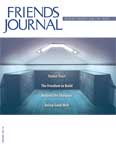
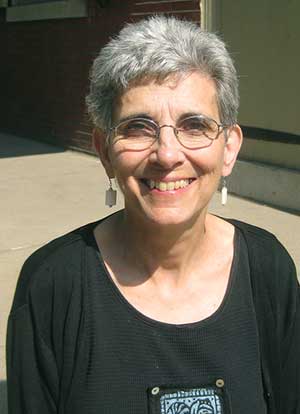
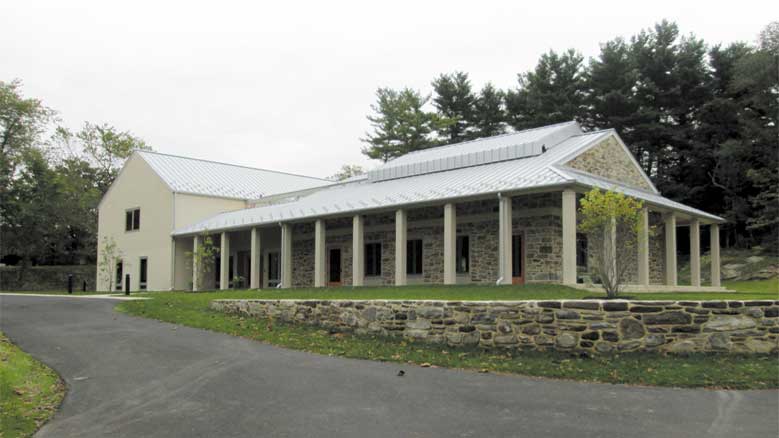
Comments on Friendsjournal.org may be used in the Forum of the print magazine and may be edited for length and clarity.